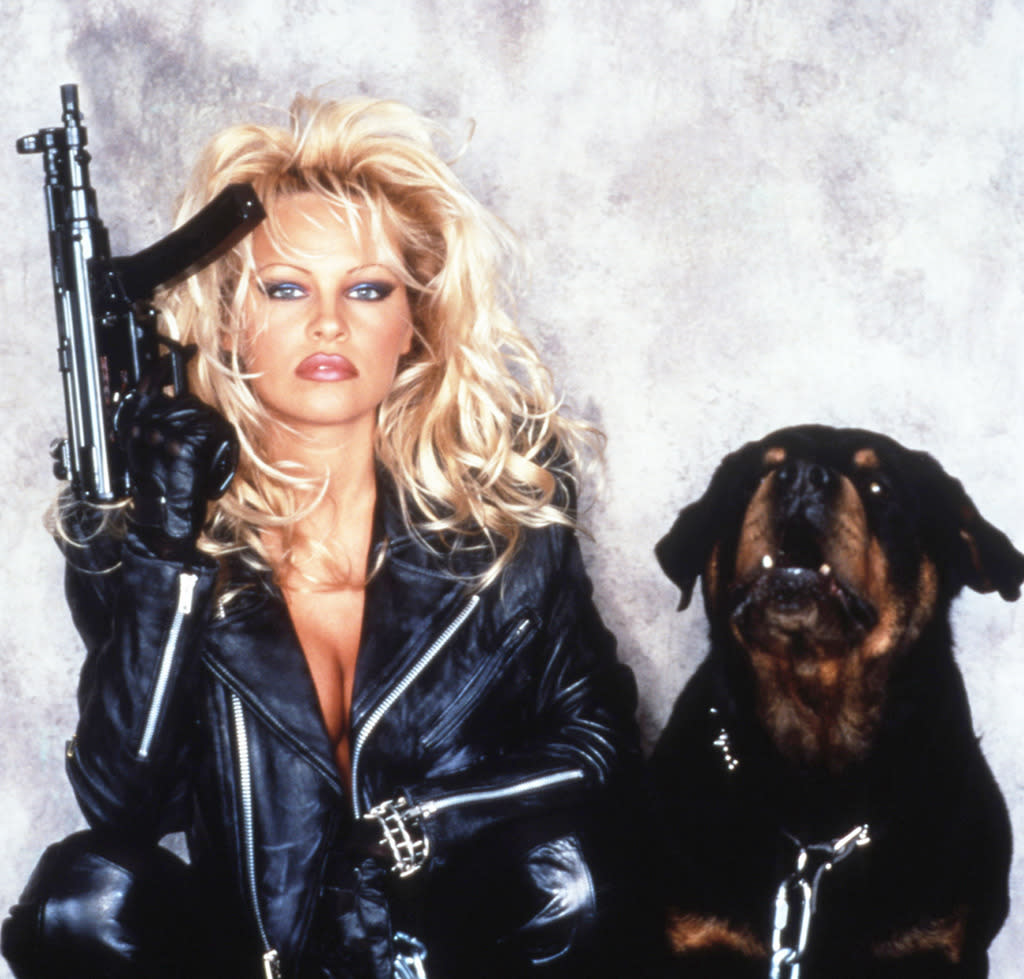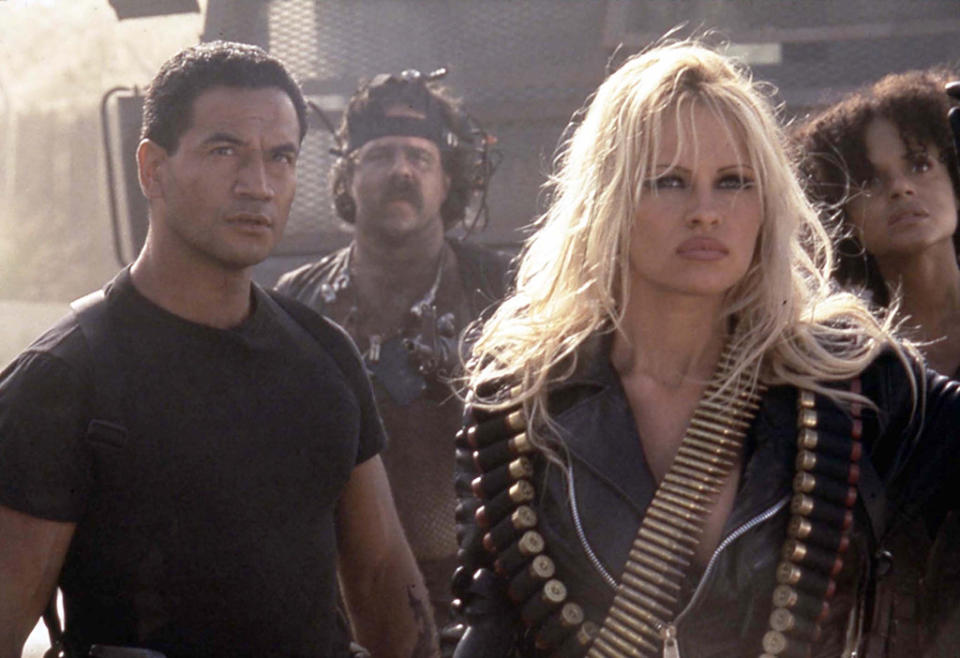Will 'Barb Wire' Ever Get a Comeback? Remembering the Notorious Comic-Book Movie Bomb

Pamela Anderson in ‘Barb Wire’ (Everett)
By Oliver Lyttelton
In the mid-’90s, comic book movies were an iffy proposition: The blockbuster success of 1989’s Batman had put superheroes back on the cinematic agenda, but megapublishers Marvel and DC had little luck getting their characters to the big screen due to a slew of budgetary, technical, or legal concerns. And while a few non-Marvel, non-DC characters had managed to make it to theaters — in such films as Judge Dredd and The Shadow — audiences mostly ignored them.
In fact, as the decade was beginning to wind down, the only big comic-book flicks were movies like The Crow and The Mask, both of which featured decidedly nontraditional heroes and had gotten their start at small, independent publishing houses. But these turned out to be flukes: In Hollywood, turning a hit graphic novel into a hit movie remained a daunting, risk-filled endeavor. And few movies of the time seemed riskier than 1996’s much-hyped (and much-maligned) Barb Wire.
Related: How Tim Burton’s ‘Batman’ Changed the Way Summer Movies Are Sold
Creator Chris Warner’s original 1994 comic focused on the titular character, a tough-as-nails bar owner and bounty hunter in the dystopian town of Steel Harbor. And for the movie version, producers settled on an unlikely star: Pamela Anderson. The then 28-year-old actress had broken through thanks to regular appearances in Playboy but had been carving out a small-screen acting career, first with a small part on the sitcom Home Improvement, then as curvy lifeguard C.J. on the syndicated hit Baywatch.
Watch the ‘Barb Wire’ trailer:
But by the mid-’90s, Anderson was just as famous for a sex tape made with then husband Tommy Lee. That lent her a certain amount of notoriety, which no doubt made her appealing to Barb Wire’s producers, who needed a performer who not only could be tough, but also could convey the right amount of teasing naughtiness. Still, Anderson’s management urged her not to take the part, telling her she shouldn’t play “a cartoon character.” But Anderson pushed back, later telling the Los Angeles Times that “nobody could play this character but me.” The actress eagerly promoted the film at Cannes before production was underway, and even went so far as to have a barbed wire symbol tattooed on her arm.
It’s rare enough to see a female-fronted action movie now (for all its success, even Marvel won’t have a film carried solely by a woman until Captain Marvel arrives in 2019), but it was even more of an anomaly in the Clinton era. In 1995 another female-led, postapocalyptic action flick — the Lori Petty vehicle Tank Girl — had landed with a thud. So it was a bold move for PolyGram Pictures to back Barb Wire, even if its budget was a modest $9 million.
Related: The Black Widow Movie That Almost Happened
The movie’s script was equally audacious: Set in 2017, and written as a direct homage to Casablanca, it cast Barb as a neutral club owner in the Second American Civil War. She’s forced into action when a freedom fighter ex-lover (Temuera Morrison) turns up with his new wife (Victoria Rowell), hoping Barb can help them get safe passage to Canada and away from fascistic government man Colonel Pryzer (Steve Railsback).
Barb Wire was clearly a tumultuous production. EW reported at the time that Anderson’s trailer had been broken into and private photos stolen. Meanwhile, Dark Horse Comics (Barb Wire’s publisher) and Propaganda Films (the production company that had bought the rights) reportedly feuded over the choice of director. Dark Horse’s choice, Adam Rifkin, began shooting but was fired after nine days (he later claimed he was a “fall guy in their power struggle”). Music video director David Hogan was brought in to replace him — as he noted years later, “the pay wasn’t bad” — but even then, the screenplay remained something of a two-headed beast. That’s probably because of its uniquely at-odds pedigree: By the time Barb Wire made it to the screen, its script was credited to both Ilene Chaiken (the openly gay writer who’d later create The L Word) and Chuck Pfarrer, a right-wing former Navy SEAL.
Perhaps as a result, Barb Wire is a schizophrenic mess: It’s muddled and messy throughout, weaving awkwardly between cartoonish comedy and grisly violence and picking up plot threads and dropping them again. And it lifts pretty shamelessly from both Blade Runner and Mad Max, the two most borrowed-from movies in sci-fi history. Making things worse, the film has a noisy, dated, and mostly awful soundtrack, including two tepid onscreen performances in Barb’s club by obscure goth/industrial band Die Cheerleader.

Temuera Morrison and Pamela Anderson in ‘Barb Wire’ (Everett)
Meanwhile, whatever feminist overtones the movie might have contained are mostly nullified by the kind of crude, sexless titillation that sees Anderson dancing in slow motion while being sprayed with champagne across the opening credits. In fact, the movie’s biggest problem might have been its star, who proved here that, while she may have looked good on a poster, she wasn’t much of an actress. Perhaps it was Anderson’s deliberate choice to play every single line in a sort of monotone — think Humphrey Bogart by way of Marilyn Monroe — but the choice never pays off, and, not surprisingly, Anderson never headlined another major movie after this. Even at its low cost, the film took just $3 million at the U.S. box office on its release in May 1996, never even cracking the top 10.
Still, for all its messiness, Barb Wire does have some redeeming qualities. Its production value is impressive for such a reasonably small-budgeted picture, its tongue is very much in its cheek, and many of the performers — in particular, future 24 star Xander Berkeley as the morally nebulous Claude Rains-ish police chief — are clearly having fun. The action’s pretty good too, particularly a film-closing brawl between Barb and Pryzer set atop a car that’s impaled on a forklift, which is itself dangling from a crane (the sequence later earned an MTV Movie Award nomination for Best Fight).
Watch the fight scene:
Ultimately, Barb Wire should be remembered more for its behind-the-scenes efforts than its actual execution. From an industry standpoint, this was a bold movie: It attempted to turn a cult comic book into a viable big-screen property at a time when that was far from easy, and — more important — it focused on a strong female action hero years before Resident Evil, Tomb Raider, The Hunger Games, and the rest. And it might even experience an unlikely revival, as a new version of the comic launched this summer, and Dark Horse is once again getting into the movie game. Who knows? Maybe Barb Wire will finally get the big-screen dystopia she always deserved.

